Ellen and Jim Have a Blog, Too
We are two part-time academics. Ellen teaches in the English department and Jim in the IT program at George Mason University.


Pallisers 8:17: The murder and Phineas "taken in"; presentation of women & romance takes a dark turn in series (4) · 26 December 08
Dear Friends,
We’ve had a transcript of a major drawing-room scene and the decision of the series’ makers not to exculpate Phineas (Donal McCann) of the murder of Bonteen (Peter Sallis) completely immediately, two blogs of summaries and commentary on Episodes 41-42, 43 and most of 44; we are up to the last scene of Episode 44 and 45.
The part concludes with a striking enactment of the murder of Bonteen by an unknown assailant. It is entirely silent, a dumb show done in semi-darkness. I have broken Episode 44 into two separate blogs (the first two scenes, 11 and 12 are in my previous blog) to emphasize how it differs from the rest of the part, and connects just as closely to Episode 45, “Taken In.” The film-makers leave the drawing-room comedy location of most of the series and attempt an active outdoors scene.
There are more of these than viewers may be aware of partly because for the most part when the characters go outdoors, they behave as if they were still on a stage or the action is theatrically blocked so as to be framed by the TV as ritual and work symbolically (e.g., the bethrothal of Lady Glencora McClusky (Susan Hampshire) and Plantagent Palliser (Philip Latham), Phineas and Chiltern’s (John Hallam) duel, the scenes at the gardens at Matching. Exceptions include the mob scene outside Parliament, and the scene of a hunt where Phineas rescues Chiltern (both occur in 4:8, Episode 37 which includes the Willingford Hunt and Episode 38, “Protesters.” The rarity of this kind of thing makes it effective.
Episode 44. “Finn Angered.” Scene 13. The matter is taken from later in the novel when we are told what happened. See 1983 Oxford World Classics paperback Phineas Redux, II, Ch 47, p. 65, where a brief summary of what the constables imagine is told by the narrator, with Phineas as treacherous murderer, and Lord Cantripp [eliminated by Raven] disbelieving it; also II, Ch 67, where Chaffanbrass now fully apprised of who did it, with a made key and Mr Meager’s grey coat in hand, tells of what occurred that night fully, with Emilius as murderer. Trollope’s Phineas Redux maybe said to work like Samuel Richardson’s Clarissa; we get a brief startling announcement of the unprepared for event (II, Ch 47, p 58), then the briefest of general surmizes, with the whole thing not delineated until late in the book.
The film to be dramatic immediately reverses this procedure. We begin with what could be seen that night. The camera shows us Fawn (Derek Jacobi) walking along; Fawn sees a carriage, then a man in black (indecipherable), a top hat and cane (Bonteen).
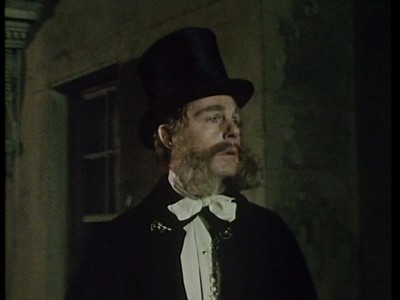
Fawn alerted to something.
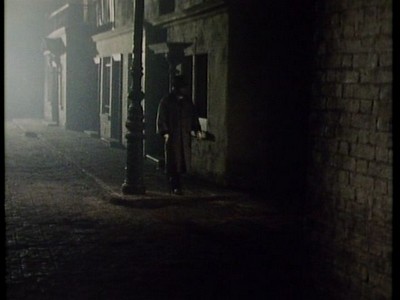
What Fawn saw.
Fawn walks off (like Phineas) in another direction. A tracking shot of Fawn walking along a street with barred windows; he sees a man with a top hat, dark overcoat and cane, rushing along in the dark. The camera now comes in at another angle and we see Bonteen walking along a street, a gate, a dog, he looks back, a bit nervous, a shadow seen on the wall, it disappears.
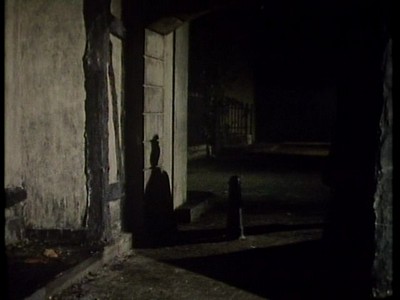
What Bonteen saw just before he was assaulted.
He turns the corner and hoists his cape up a bit, and turns round and sees a man. We hear “What the devil!”, and we see a man lunge at him with a bludgeon hammering him to death. The last part is blocked as if we were watching a staged play. The gray coat and life preserver are clearly seen. Some emitted sounds from the body on the dark stairs and the scene goes blackish and grey and we see
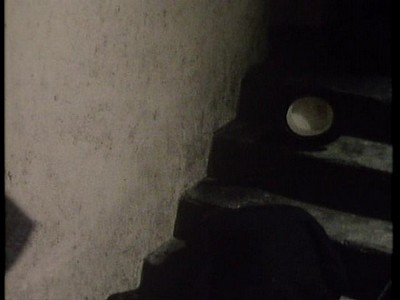
the Death of Bonteen, his corpse under the cap, and top hat.
Episode 45. “Taken In.” Scene 14) Hall just outside Phineas’s lodgings, all black turning to dark brown, and a hard knocking. Scene taken from Phineas Redux, II, Ch 49, pp. 75-76, 77-80, also II, Ch 52, p 100. In Trollope the friends Phineas is found with are Low (his old barrister mentor) and Chiltern. But Low has been eliminated by Raven; Phineas is also warmly defended by Mrs Bunce, but the actress (Brenda Cowling) is not brought back by Raven after 5:10.
As the dark brown door opens, we get a mastershot of Phineas’s room, it’s morning and he’s writing at his desk. A dialogue between Lord Chiltern (John Hallam) and Phineas; they discuss the irritability, boredom and disappointment of Lord Brentford (Lockwood West), and Chiltern tells Phineas that Lady Laura Kennedy (Anna Massey), now a widow, wants to share her enormous income with him. Phineas, the honorable man who will not be supported by a woman he’s not married to, says this is “out of the question,” and Chiltern’s love for Phineas, their camaraderie is roused.
Again a knocking at the door, and Phineas opens it, and a distressed Barrington Erle (Moray Watson) enters the room. Phineas immediately sees something is the matter and Erle tells of Bonteen’s murder; although Phineas tells Chiltern of his quarrel with Bonteen at the club, with Erle supplying more details, Phineas does not at first conceive he will be accused, and when Erle makes him understand this, Phineas becomes indignant and insists on putting his bludgeon on the table for the police to find if they should come. They do.
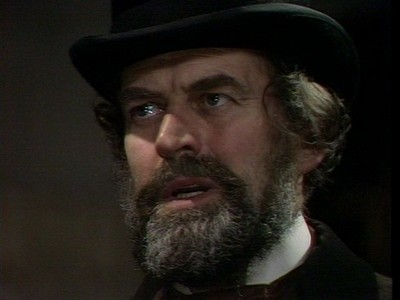
Barrington Erle distressed.
A strong scene ensues when the police come in between Phineas, Chiltern, and Superintendent Worth (Anthony Carrick) with his police aid (not identified by name in the cast) helping him. Worth clearly sees in Phineas the probable murderer and Phineas refuses to acknowledge he needs to defend himself by hiding any suspicious evidence. Phineas is at first curt to the officers, requiring they leave as soon as they finish their official business with him, then is candid about how he and Bonteen feel (the officer corrects him: “the past tense would be more appropriate, sir”) about one another: “I hate him and he hates me.” This is a partial paraphrase of a lines in earlier scenes between Phineas and friends where he openly confesses his hatred. In Trollope’s scene Phineas is not so foolhardy. After the police elicit from Finn his version of what he did after he left the club (went home), they tell him of Fawn’s testimony which incriminates him thoroughly, to which Chiltern (in all body language throughout strongly faithful to Phineas as a friend) retorts, “Upon my soul, Lord Fawn sees in the dark like a cat.”
Worth. “The figure passed under a street lamp, my lord.”
Chiltern. “Gaslight can make a great diference as to color, superintendent.”
Worth. “Lord Fawn also remarked the cut of the coat. And now Mr Finn, pray do not trouble to take if off. Sergeant … Phineas Finn, it is my disagreeable duty, sir, to ask you to accompany me forthwith to Bow Street police station. I must also warn you that anything you say from now on may be taken down in writing and used in evidence.”
As Phineas begins to look gravely at his friends and walk with them, we have a closing close-up of him:
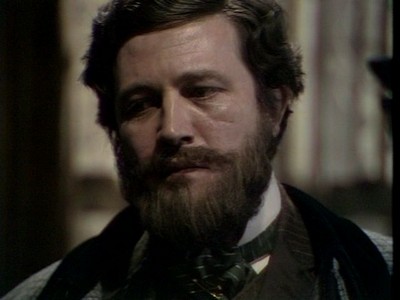
Phineas arrested.
As in the first part of the series where a number of the parts ended on close-ups of the agonized face of Burgo Fitzgerald (Barry Justice), discarded to make way for the heir of the powerful hierarchy to marry Lady Glencora, whom Burgo loved and whose money he desperately needed, so a number of the parts of Phineas’s story ended on Phineas’s face looking grave, but he has never shown the cost of his ambition quite so starkly before. During the scene with Barrington and Chiltern, he had wondered rhetorically, “They cannot suppose that I would kill a man for [promotion]” and was cut off by Chiltern’s instinctive hiss, “Phineas.” For people can and will suppose he did just that. In Trollope’s Phineas Redux, the word used is “advancement.”
Also commemsurate with the change in Trollope’s text into a darker mood, the depiction of love romance is changing. We are to imagine a later period with slightly different mores: the film-makers’ evident desire, as evidenced in the women’s change of fashions from bell-like dresses, Dickensian-movie curls and simple hats to bustles, tighter hairdoes and fashionably elaborate hats, has the later films as taking place in the later Victorian period. The theme of underlying cruelty when one person has social domination over another is in 8:17: Maule (Jeremy Clyde) jeering at Adelaide (Jo Kendall) and his ease in stringing her along, and the Prince’s ridicule of Bonteen and Fawn are the two strong instances.
The specifics of the first show a change in the presentation of romance. The young man is after money and she is not innocent of a desire for sexual hardball playing. The presentation of Maule and Adelaide then anticates the way the series will present Trollope’s story of Emily Wharton (Sheila Ruskin) as that of a young woman sexually enthralled by the mean hard handsome bully, Ferdinand Lopez (Stuart Wilson). Emily is dressed the sexiest of any of the exemplary heroines and she ends in retreat. This is a kind of pornification equivalent to what we see in teenage girls today (with push up bras and wearing lingerie tops):
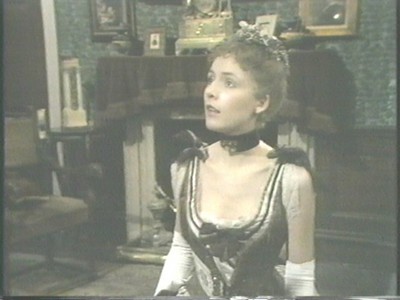
Our first view of Emily Wharton (Part 10:20).
So we will be with her on the opposite side of a continuum from that the story of the Duchess’s early ideal love, decision to forego and engagement and success in the world (in the French sense of “le monde”).
The intensity of the matter and charged fully-developed interacting personalities made this part fluid, so that the divisions of the episodes are artificial, and so it will continue in 9:18 and 9:19, Phineas’s ordeal.
See various links and a concise summary of 1:1-3:6, 4:7, 4:8, 5:9, 5:10, 6:11, 6:12, 7:13, 7:14; 8:15, 31-33, 8:15, 34-35; 8:16, 36-38, and 8:16, 39-40
--
Posted by: Ellen
* * *
Comment
- A summary of the four:
Another four articles on the 1974 BBC Palliser series, this set on Part 8:17. This part is a commentary adaptation (to use Wagner’s terminology) of Phineas Redux, with a scene that anticipates the matter of The Duke’s Children as adapted by Raven.
http://server4.moody.cx/index.php?id=990 Pallisers 8:17: The Palliser family romance begins in earnest; a significant departure from Phineas Redux (I transcribe a wholly invented scene of conflict between the adolescent Silverbridge and new Duke of Omnium; and I discuss how Raven encourages viewers to believe Phineas could have committed the murder)
http://server4.moody.cx/index.php?id=991 Pallisers 8:17: An array of male gentleman types across the series; the vexed nature of life potentially more dangerous than it appears (I survey the whole series for a continuum, discuss a them of this part, and summarize 2 episodes
http://server4.moody.cx/index.php?id=992 Pallisers 8:17: The story horizon opens out perceptibly (soap opera aesthetics of the series as a whole, and summary of another 2 episodes)
http://server4.moody.cx/index.php?id=993 Pallisers 8:17: The murder and Phineas “taken in;” presentation of women & romance takes a dark turn in the series (summary of last episode and return to surveying series as a whole, this time in terms of women and men’s heterosexual interactions).
— Elinor Dec 27, 12:24pm # - Comment by William Baker:
“Just come across your fascinating Palliser blog and posting. Been spending the break watching the 12 DVD’s of The Pallisrers. Absolutely wonderful and at times moving,compelling viewing. Shall miss the music as well.
A question though for you NOT for VICTORIA please. Why does AT have to be so anti-Jewish: the scoundrels largely are of Jewish origin with the exception of course of Bonteen. Md Max is very Ok but her origins are obscured. Now I know there is the exception of Nina Balatka in AT’s work and that my friend John Sutherland has vigorously defended AT against the charge, but the BBC adaptation didn’t disguise this element in Trollope’s The Pallisers.
A very Happy New year to you and yours
Bill"
— Elinor Dec 27, 12:26pm # - Dear Bill,
And I wish you a good holiday season and coming new year too. Thank you very much for this note.
On anti-semitism in Trollope: I know that Sutherland and others defend Trollope against the charge by referring to the hero of Nina, Breghert in The Way We Live Now and the way Madame Max is first represented in CYFH?. For Madame Max not only is her background left partly obscure, but Trollope backtracks on it to make her more acceptable once he decided to make her a central heroine. He dropped the remittance man and possible second marriage and turned her into a chaste heroine not a demi-monde as she was at first. And two characters do not make enough of an argument when you think of several portraits that are electrifying in their visceral antisemitism: not only Emilius, but Ferdinand Lopez, Melmotte (who is supposed to be Jewish or enough Jewish). I sometimes think Trollope is simply being unscrupulous and using Victorian anti-semitism to make a villain portrait quickly. He could not have predicted the concentration camps of our era, might not have known of the centuries of pogroms. But this is disingenuous and I feel one just has to admit that anti-semitism was rife in the Victorian period and Trollope shared it.
What bothers me is the BBC repeats it. I think they should not have done this. They didn’t do it in the recent WWLN. These are programs made today for today’s audience and to do this is to spread anti-semitism and make it acceptable. I don’t think you would have seen such a program in the US because Jewish people are more vocal and active in the arts in the US.
It’s not good to bring the topic up on Victoria because it is a charged one today. Recently wasn’t there another thread on Fagin?
Well that’s my take anyway. As you can see, I’m studying the films and hope to write a paper or even monograph and maybe even a published book on it. If not, I’ll pull the set together and make a page on my website where people can read a thorough study of these films. If you could make a suggestion as to which journal might be the one to send a paper to, I’d be grateful for suggestions. I’m not sure which ones are more amenable to film adaptation studies.
Cheers to you and your wife and family,
Ellen
— Elinor Dec 30, 10:58am #
commenting closed for this article
